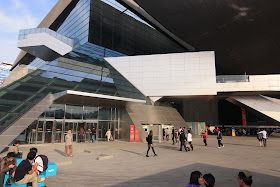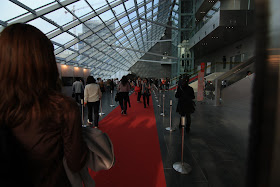The journey begins in Chumphae, a westerly district of Khon Kaen Province and frontier for lowland wet-rice agriculture. Any further west and the mountains of Petchabun come into play. The approach to Chumphae along highway 12 - which runs the width of north-central Thailand from border to border - is marked by a drastic shift from rural to urban, rice paddy and cane field to concrete slab. From the road, it looks as if an entire Bangkok neighborhood has been broken off from the megalopolis and flung into the countryside, one enormous discarded piece of a jigsaw puzzle. I am reminded that in Thailand, concrete is not only the building material of choice, but it is the building material of empire.
To escape from this concrete monotony, which is wholly encompassing in Chumphae, a near monopoly, one must turn to the movie theater - which is also made of concrete. Reprieve can be found in the form of an enjoyable film, but more firmly in the notion that the Chumphae Cineplex, as it is named, serves a function not unlike a public square: a space for social interaction, or quiet relaxation. I found a bit of both in the spacious and airy lobby of the this late-addition stand-alone.
 A hand-painted billboard advertises the latest Thai ghost-comedy, Ban Phee Pob. Behind it, the Chumphae Cineplex is aglow in morning light.
A hand-painted billboard advertises the latest Thai ghost-comedy, Ban Phee Pob. Behind it, the Chumphae Cineplex is aglow in morning light. Just like the Chumphae Cineplex, a large portion of Thai stand-alone movie theaters are set back in courts, plazas, or otherwise removed from street-side adjacency. Although the space in front is often used by movie-goers to park their motorbikes, the distance between theater and thoroughfare serves as insulation against noise, pollution and noise pollution. As public space is painfully absent in most Thai urban areas, a downtown cinema, with an open-air lobby, is indeed, akin to a park.
Just like the Chumphae Cineplex, a large portion of Thai stand-alone movie theaters are set back in courts, plazas, or otherwise removed from street-side adjacency. Although the space in front is often used by movie-goers to park their motorbikes, the distance between theater and thoroughfare serves as insulation against noise, pollution and noise pollution. As public space is painfully absent in most Thai urban areas, a downtown cinema, with an open-air lobby, is indeed, akin to a park. Simply designed, with a true functionalist aesthetic, the Chumphae Cineplex .
Simply designed, with a true functionalist aesthetic, the Chumphae Cineplex . The term "cineplex," when applied to a single-screen, stand-alone movie theater is a little misleading. Breaking the compounded word into two we are left with "cinema" and "complex," which implies a plurality of parts. Conventionally speaking, a cineplex will either have more than one screen, or more than one function. But in the case of many late-era Thai stand-alones, of which there are few, the term is applied for strictly semantic reasons. Cineplex sounds more up-to-date, more fashionably modern than the traditional terms of "cinema", "theater," or, in the Thai lexicon, "rama." So don't be fooled! The Chumphae Cineplex, along with a handful of theaters to come, are in actuality stand-alones.
The term "cineplex," when applied to a single-screen, stand-alone movie theater is a little misleading. Breaking the compounded word into two we are left with "cinema" and "complex," which implies a plurality of parts. Conventionally speaking, a cineplex will either have more than one screen, or more than one function. But in the case of many late-era Thai stand-alones, of which there are few, the term is applied for strictly semantic reasons. Cineplex sounds more up-to-date, more fashionably modern than the traditional terms of "cinema", "theater," or, in the Thai lexicon, "rama." So don't be fooled! The Chumphae Cineplex, along with a handful of theaters to come, are in actuality stand-alones. Lower lobby view
Lower lobby view In the shark's jaws and ticket vendor's hands
In the shark's jaws and ticket vendor's hands In a way, an art gallery.
In a way, an art gallery. A cinematic transaction.
A cinematic transaction. Upper lobby.
Upper lobby. Lobby lounging
Lobby lounging 
 The Chumphae Cineplex auditorium has just over 200 seats. Not a giant like those built during the height of Thailand's movie theater boom. But that, of course, was a different era.
The Chumphae Cineplex auditorium has just over 200 seats. Not a giant like those built during the height of Thailand's movie theater boom. But that, of course, was a different era.Thailand's all-time highest grossing film, Suriyothai, did wonders for the domestic movie theater industry. In some cases, theaters which had gone out of business in recent years prior, reopened for exclusive screenings of this royally produced (and I mean that literally) historical epic. That was in 2001, the same year the Chumphae Cineplex came into existence. It might be a stretch to say that this late-era stand-alone was built to capitalize on the publicity of Suriyothai, but the timing didn't hurt. More generally, one can easily imagine desperate exhibitors, owners of theaters on the verge of shutting down, getting their hopes up as capacity crowds turned out on a nightly basis for the propaganda. A palliative event, however, in the long run. Demographic shifts, the spread of home entertainment, combined with the opportunism of multiplex chains have ensured a slow death for the independent theater operator.
The manager of the Chumphae Cineplex - a bizarrely attractive woman to be running a small town movie theater - casually mentioned that she would be closing it permanently in the near future if attendance didn't pick up.






















